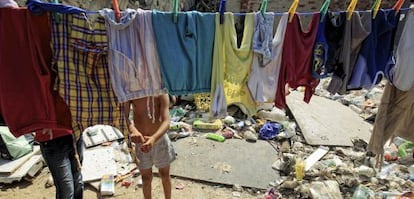What to do with Cañada Real?
Madrid City Hall wants to bulldoze part of Europe's biggest shanty town

"In Cañada Real lives a large part of the population of Madrid in a permanent manner, which has rights but also responsibilities. The illegal status of the vast majority of the plots of land is a fundamental aspect, but it must not be the only one," reads a Madrid City Hall social report on the largest unauthorized settlement in Europe. The document, to which EL PAÍS has had access, is the first step toward a solution to the situation, which carries significant social and logistical problems. "The expulsion of this populace and the restoration of the zone to its original state will not solve the problem, as it will simply move elsewhere and leave many of its inhabitants in a worse situation," the report sums up. But neither can all of the residents be relocated, ostensibly to council-owned properties, or compensated because such action would lead to a "comparative affront" to the manner in which other shanty town evictions have been carried out in Madrid.
"The balance is therefore very complicated," the report continues, especially in view of the ongoing economic crisis and "contentious public expenditure." City Hall has thus called for a "substantial dose of realism."
Cañada Real is built on a drover's thoroughfare, which in Spain are considered public property and legally protected. They cannot therefore be built upon, bought or sold. Cañada Real consists of an extended strip of land 13 kilometers long and between 40 and 80 meters wide, stretching from Coslada, which lies outside city limits in the northeast of the region, through the Madrid suburbs of Vicálvaro, Rivas-Vaciamadrid and Villa de Vallecas. Six-and-a-half kilometers, therefore, fall under the remit of the Popular Party-run City Hall, which conducted a census on this stretch in line with regional law. The regulations, which are opposed by the Socialist Party opposition in Madrid and the three neighborhoods affected, allow for the reallocation of the land. If a social consensus between the Madrid regional authorities, local town halls and the central government delegation is not reached within two years, the PP regional government will take control of the land.
What does Madrid City Hall propose? It views simple legalization of the settlement as unviable, because it "radically" fails to comply with the most basic urban regulations. Cañada Real is too close to the Valdemingómez garbage dump and the city's southeastern regional park. It is also enclosed by major highways and has no public services or transport. Furthermore, a "large number of homes are in a bad state," and its social fabric is a "combination of the most problematic and least sustainable groups, who have a tendency to form ghettos." Finally, there is the problem of delinquency, such as building "speculative" settlements as a strategy to negotiate compensation with the authorities, as well as the sale of drugs. According to the report, 90 percent of all drugs sold in Madrid come from Cañada Real.
The regeneration of the settlement has been "completely" ruled out, "as it is very likely that within a few years it will suffer continual and permanent deterioration." Creating a new neighborhood is not on the agenda, and the "radical" solution of simply bulldozing the settlement has been shelved. City Hall has therefore proposed an "open proposition" that consists of regularizing some areas and removing others to create green spaces, while also providing "palliative services."
City Hall therefore proposes "consolidating and legalizing" the first stretches in Vicálvaro, which are "clearly sustainable and viable," by connecting them to existing neighborhoods. It also suggests altering city limits to incorporate a part of the Rivas-Vaciamadrid stretch. This would bring 1,202 residents into the fold. The remainder of the settlement would be demolished to create green spaces, with some 60 percent of the 4,464 people affected to be relocated by the authorities. "At least 40 percent of families would have to resolve their housing needs themselves. The rest will be relocated, as long as they meet the habitual standards in this process," the report concludes.
Tu suscripción se está usando en otro dispositivo
¿Quieres añadir otro usuario a tu suscripción?
Si continúas leyendo en este dispositivo, no se podrá leer en el otro.
FlechaTu suscripción se está usando en otro dispositivo y solo puedes acceder a EL PAÍS desde un dispositivo a la vez.
Si quieres compartir tu cuenta, cambia tu suscripción a la modalidad Premium, así podrás añadir otro usuario. Cada uno accederá con su propia cuenta de email, lo que os permitirá personalizar vuestra experiencia en EL PAÍS.
En el caso de no saber quién está usando tu cuenta, te recomendamos cambiar tu contraseña aquí.
Si decides continuar compartiendo tu cuenta, este mensaje se mostrará en tu dispositivo y en el de la otra persona que está usando tu cuenta de forma indefinida, afectando a tu experiencia de lectura. Puedes consultar aquí los términos y condiciones de la suscripción digital.








































